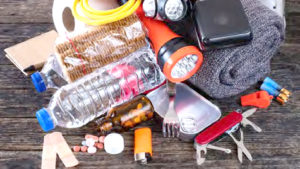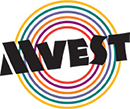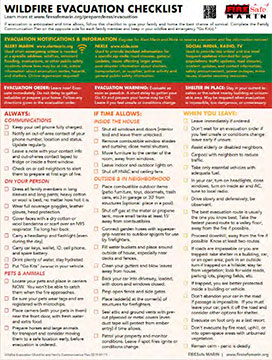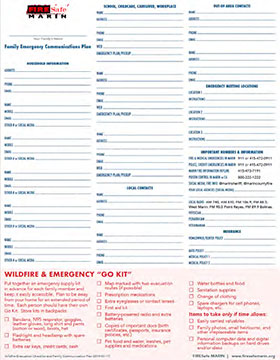Evacuation
PART 1 — Your Emergency Go-Bag
focuses on preparing our go-bags. This part includes a description of the various emergency alerts, warnings, and orders; how we can connect with them; and under what circumstances they actually work here in Marin Valley. (From the March ’22 Echo)
PART 2 — Alerts, Warning, Orders
is intended to increase your awareness and preparedness for a possible evacuation. (From the April ’22 Echo)
.
PART 3 — Alarm to Car
guides you through the steps between receiving an evacuation order and getting into your car to leave. With all this preparedness behind you, the last step will be a PRACTICE EVACUATION EXERCISE for us to put it all together and see how it works. (From the May ’22 Echo)

Evacuation: the time to ACT.
NOW: the time to PREPARE.
PART 1 — Your Emergency Go-Bag
It’s becoming more and more likely each year that there will arrive that ominous day when first responders will order an evacuation of Marin Valley. Why? Something bad would be about to happen like an approaching wildfire; it won’t be safe to stay home, and staying home would impede first responders from doing their jobs. Visibility and air quality will be dismal; it may be dark, and you are not likely to be at the top of your game of clearly thinking of all you may need to do, so it better be very simple. You will need to very quickly leave home and you may be gone for days or a very long time. You may return to something or maybe not, but that’s another story. Will you be ready? If you aren’t, chaos and panic can — as has often been demonstrated — cause as much or more danger to you than the actual emergency. Emergency evacuation preparedness and practice can make for an orderly process, save lives and nerves, and help responders to move on to their job of saving your home. MVEST will help guide us all through the process of planning and conducting an orderly evacuation.
Evacuation can be a daunting experience in our complex and busy lives, so we’re chunking it down into four bite-sized pieces as follows:
1) planning and preparing an emergency go-bag,
2) alerts and warnings used by first responders in our area, and what to do when they occur,
3) the surprisingly not-so-simple act of grabbing your bag and getting into your car, and
4) putting it all together in a “full dress rehearsal” evacuation exercise.
Let’s start at the beginning with your go-bag. Many of us have previously completed this step, and if this is you, now’s a good time to review and refresh your Go-bag. (Stale almonds suck!)
Go through your go-bag ideally every six months and evaluate how to keep it updated. One way you could remember to do this is to choose a certain time, such as the change to Daylight Savings Time. Every time that date comes up, you know it’s time to go through your 72-hour kit. You could also use your smartphone to set a reminder on your calendar to update your kit.
Federal Emergency Management Agency (FEMA) recommends you keep a 72-hour kit. There are a lot of suggested emergency kit lists and kits you can purchase. Those might not be tailored to fit your needs. Make your own list.
Here in Marin, we have a tremendous resource right at our fingertips—Fire Safe Marin. You can peel off a copy of the Evacuation Checklist from the tablet on the front counter at the clubhouse or download it from the FireSafe Marin website at: https://firesafemarin.org/wp-content/uploads/2017/03/FIRESafe_MARIN_ Evacuation_Checklist.pdf
72-Hour Go-Bag
Build a 72-hour go-bag for each household member so that you can have it in-hand as quickly as possible. You should include anything you might need for at least 72 hours. Include:
-
Food and water with good shelf-life
-
Clothes and gear for a safe exit — day or night — and a change
-
Maps for navigation
-
Plans and materials for basic survival — warm blanket; N95 masks; bandanas; personal essentials like glasses, medications, toiletries; cash in small bills and credit cards
-
Facilitation for possible extended absence — important documents and account access and passwords
-
Communications — cell phone, important contacts, charger
-
Personal safety — flashlight (head lamp), extra batteries, first-aid kit, pocket knife, whistle, can opener, and portable radio
-
Pet care supplies
On-the-Go Bag
Keep your go-bag in a safe place (cool, dry, and very convenient). It must be easily accessible; you may not have a lot of time to grab your kit before you need to leave your home. Then, while you’re at it, we recommend that you make a smaller on-the-go bag that you can keep hidden away in your locked car.
A walk along Marin Valley Drive indicates that we are a very mobile community. What if you’re out and about while an evacuation order is issued? Think about how often and how long your excursions are and adjust the extent to your on-the-go-bag accordingly. As you build this kit, plan for fluctuations in temperature that come along with being in a car. Include car-specific items (such as road flares). Aim to keep a full tank of gas in your car (or full charge) as much as possible.
Practice Makes
Perfect Better
A successful emergency evacuation is totally dependent on YOU — your awareness and your willingness to participate in the program.
All communication is like your radio: both the transmitter and receiver must be turned on.
PART 2 — Alerts, Warnings, Orders
With the current climate change-induced megadrought and rapidly ballooning year-round threat of destructive wildfires, Marin fire agencies have doubled down on emergency evacuation as a primary wildfire-response measure. The more obvious reason for this is to get residents out of harm’s way; the not-so-obvious reason is to greatly increase the efficiency of fire-suppression measures.
The first priority of first responders is ALWAYS to save lives; attacking the fire comes second. So if people are still in harm’s way after an evacuation is ordered, precious “initial attack” time is squandered as fire suppression activities must be delayed until everyone is clear. This means that those individuals who choose to disregard an evacuation order are not only putting themselves in danger but also are preventing the fire services from attacking the blaze while they needlessly risk their own lives to conduct a rescue operation. The result will be counterproductive.
This is why it is imperative that we do our wildfire mitigation work — defensible space and home hardening — and evacuation preparedness well ahead of time to help save our homes and lives, and to help the fire services do their job of suppressing wildfire.
At least 10 different systems are in place county-wide to convey information about wildfire threats. For simplicity and clarity, we’ll group the most useful ones into three categories according to urgency: ALERTS, WARNINGS, and ORDERS.
Evacuation ALERTS and ADVISORIES
Alerts are the least urgent, but as the name indicates, it’s time to heighten your senses. A wildfire needs a breeze to fan flames and dry grass, brush, and/or other flammables to fuel a fire. All it takes to finish the wildfire equation is an ignition. Step outside or look out the window. If it’s dry and breezy, be on the alert for the smell of smoke or smoke on the horizon. If this is the case, it’s time to tune into other alert services.
Nixle
Nixle is a media messaging service that you can sign up for with any emergency service in any area you choose. Good local sources include Marin County Fire Department, Novato Fire Protection District, Marin County Sheriff’s Office, and Novato Police Department. You can choose email, text message, or both for receiving notices. This is a very good way to stay abreast of local emergencies. Sign up at www.nixle.com or text your zip code to 888-777.
Social Media,
Broadcast Radio,
and TV
Emergency information is often broadcast on social media such as Facebook, Twitter, and Nextdoor as well as on radio and TV. These may be useful for monitoring the progress of emergencies, but can be late and inaccurate.
Marin County
Emergency Portal
This is a frequently updated website that includes all local emergencies and incidents. Go to www.emergency-portal-marincounty.hub.arcgis.com and pin the page to your browser for easy access.
Evacuation WARNINGS
Alert Marin
For several years MVEST has requested residents to sign up with Alert Marin. Go to www.alertmarin.org to register. This is the only service that will provide directives that require ACTION specifically to you or our neighborhood. An EVACUATION WARNING means that an evacuation order is imminent or highly likely; prepare immediately or leave early.
Zonehaven
This is a relatively new service. In a wildfire or other emergency situation, law enforcement and fire agencies issue evacuation warnings or evacuation orders for impacted areas to any zone with an evacuation status. You can find our zone (NOV-E011) at www.myzone.zonehaven.com. Use Zonehaven to monitor evacuations and warnings in progress nearby.
Alert Wildfire
When you sense smoke, go to www.alertwildfire.org on your computer and select the North Bay Region. Nearly 100 cameras are positioned on nearby mountaintops constantly searching for wildfire smoke. The cameras are trained on the wildfire to monitor suppression progress. You can watch, too, in real-time.
NOAA Weather Radio
This is an excellent service, but probably not for us. The station we would need to tune to provides very spotty reception in the Park, even outdoors. The metal roofs on most of the homes in Marin Valley effectively eliminate any chance of reception.
Red Flag Advisory
and Warning
Red Flag Days (RFDs) are weather phenomena that are occurring more frequently and lasting longer with each year. RFDs are special weather conditions characterized by (1) low humidity and fuel moisture and (2) elevated wind and air temperature. They are usually caused by a Diablo wind: an East-to-Northeast wind that is dry, warm, and very strong at higher elevations. An RFD may also be issued when there is a substantial threat of dry lightning. RFDs are issued by the National Weather Service and advertised by the Fire Department and other emergency services, and by weather forecasts. MVEST advertises RFDs here with two red feather sails at the clubhouse and a Red Flag Day banner, as well as a red flag on the flagpole at the top of the hill entering/exiting the Park.
Nearly all major wildfires and many smaller blazes begin on RFDs. The fire that seriously threatened Marin Valley in 2016 occurred on the last RFD of the year. An evacuation order was made but was quickly rescinded when the fire threatened our secondary evacuation route. We then had to shelter in place.
RFDs are times to be especially alert for signs of wildfire and are great opportunities to do some last-minute fire mitigation and preparedness chores.
Red Flag Advisories are issued 2–5 days before a warning, giving more time to:
- Blow leaves away from your home (embers accumulate wherever leaves do).
- Bring in combustibles (brooms, lawn furniture, towels, etc.).
- Place garden hoses and water buckets out for firefighters to use.
- Make sure your car is fueled/charged and parked in your driveway facing the street.
- Close windows/doors; unlock doors; leave some lights on.
- Open or remove curtains and blinds from directly in front of sunny windows (they could ignite from heat transmitted through glass).
- Review your evacuation checklist and official route, and perhaps warn your nearby relative you may be showing up.
- Check that your list of contacts is current.
Also consider some go-bag extras:
- computer/charger/USB drive
- cell phone, charger
- cash (small bills are best)
- keys
- fresh current meds
- fresh water in car
- lay out clothing to wear during evacuation:
— cotton pants like denims
— long-sleeve cotton shirt
— high-top shoes or boots /cotton socks
— hat, full brim; sunglasses
— N95 mask + bandanna
Leave Now
Evacuation ORDERS
The highest level of urgency is an Evacuation Order. It simply means to LEAVE — NOW.
The official service is Alert Marin, reiterating the necessity for you to register.
However, redundancy for this essential message is crucial, so there are a couple of fallbacks to help ensure that everyone “gets the memo”:
Police Cruiser Hi-Lo siren
The first will be a police cruiser driving through the Park with a special Hi-Lo siren that is used only in case of an evacuation order. For a demonstration see the home page and scroll down to the MVEST article on the Hi-Lo siren. Then follow the links to a Facebook video.
MVEST bullhorns driven through Park
MVEST also has a contingency plan in case all else fails. We will drive through the Park with bullhorns that also work as sirens.
Shelter in Place
A possible alternative to an evacuation order may be an order to shelter in place when evacuation is deemed unsafe or when sheltering is the better option.
EVACUATION ALERT — Ready
Nixle www.nixle.com
Marin Emergency Portal www.emergency-portal-marincounty.hub.arcgis.com
Social Media Facebook, Twitter, Nextdoor
EVACUATION WARNING — Set
Alert Marin alertmarin.org
Zonehaven myzone.zonehaven.com
Alert Wildfire www.alertwildfire.org
Complications
Power and
Infrastructure
Failure
Complications
Power Failures
However they happen — be it a planned PSPS (public service power shutoff) or a surprise grid failure — power failures present us with special challenges, particularly concerning emergency alerts, warnings, and orders. If necessary, the City of Novato will step in to make sure the emergency messages get through.
Infrastructure Failures
Our experience is that power failures are inevitably followed by infrastructure failures, particularly internet and telephone service. The good news is that MVEST radios are infrastructure-independent. The bad news for Park residents is that, while Comcast, Verizon, and ATT are aware of the issue, rectification is progressing at the speed of bureaucracy. Jungle drums, anyone?
Video
Resources
Video Resources
https://www.youtube.com/c/FIRESafeMARIN/playlists Scroll down to the Evacuation playlist; view full playlist; choose from a great AV selection.
PART 3 — Alarm to Car
We have no way of knowing all the reasons for mandatory evacuation of Marin Valley, so we chose two of the most likely scenarios on which to model our focused preparedness. The elevated risk of wildfire here in Marin Valley, plus the fact that wildfire evacuations are becoming increasingly more common, guided our choice of using a threatening wildfire for the two scenarios. In Scenario I, we would have about two hours between the evacuation warning and the order to leave. In Scenario II, we would be ordered to evacuate immediately and would have no warning at all. In preparation for either case we strongly recommend that you review Emergency Evacuation Parts 1 and 2 in the March and April Echos, respectively. As nearly every wildfire in California in the last few years that has been too difficult to quickly contain also occurred on a Red Flag Day, we are assuming the same setting for both of our scenarios.
SCENARIO I
TWO-HOUR
Warning
SCENARIO I — Two-Hour Warning before Evacuation Order
Let’s assume you have conscientiously prepared your go-bag and that you’ve already completed your Red Flag Day essentials — what else is left? Well, that depends on you and your personal maintenance level. Following are lists of additional things you may want to consider. As everyone’s needs will be different, we suggest you make your own list and PRIORITIZE it from most to least essential.
Your
Ride
Your Ride
- If you are dependent upon someone else for your safe evacuation, finalize those specific arrangements now. Be sure to have a “Plan B” driver … just in case
- Freshen drinking water in your car
- Keep a “relief container” in your car
Your
Person
Your Person
- Dress for extreme exposure and protection — long-sleeved cotton or wool only (no synthetics), solid shoes, wide-brimmed hat
- Hydrate yourself
- Monitor for evacuation updates
Last
Minute
Planning
Last-Minute Planning
- If you have prearranged to shelter remotely with a friend or relative, now’s the time to let them know you may be showing up very soon
- It’s a good time to alert your primary local and remote emergency contacts (friends, relatives, coworkers)
- Pull out your official evacuation map (previously provided to each local address by the Novato Fire District) and refresh your memory, then keep it handy in your car
Ideally the go-bag accessories and home prep items would have been checked off on an earlier Red Flag Day, but just in case …
Go-Bag Accessories
Not in Your Go-Bag
Go-Bag Accessories
- Laptop/charger/updated USB drive
- Cell phone/charger/backup battery
- Additional important documents not already in your go-bag
- Cash/checkbook/small valuables (jewelry, keepsakes)
- Keys
- Updated meds
Home Prep
Inside
and
Outside
Home Prep
- Bring flammables indoors (doormat, deck furniture, etc.)
- Close windows/doors
- Leave doors unlocked
- Leave some lights on indoors
- Leave side yard gates open
- Leave garden hoses connected and out front for fire agency use
- Leave buckets of water out front for fire agency use
This is not a comprehensive list, just some suggestions. You may wish to add or delete from your list according to your needs. For example, I will be sure to grab my stash of chocolate bars on the way out the door — not leavin’ them behind.
SCENARIO II
NO
Warning
SCENARIO II — No Warning
From your prioritized list for Scenario I, do what you can do very quickly as time allows. First priorities should include “Your Ride” and “Your Person.”
Try to leave immediately (within about 10 minutes). The longer you take, the greater your risk and the longer you’re likely to sit in traffic. It has been shown time and again that your car is the safest place you can be during your evacuation. When you get into your car, you’ve already accomplished the greatest part of your emergency evacuation, so don’t “blow it” down the road.
Road
Trip
Final Stretch
Road Trip
The last step of the evacuation will be the easiest if you have prepared as recommended. It’s the final stretch, the sprint to the finish line — the “Car-to-Safe-Shelter” step. The word “car” is a place holder for whatever safe, enclosed transport you may choose — car, truck, bus, motorhome, etc. Please don’t consider evacuating by bicycle, motorcycle, or on foot. Exposure to the elements during a wildfire can be brutal, even lethal.
- When you get into your car, take a deep breath and let it out slowly. This will help reduce your greatest remaining threat — anxiety. Do it again whenever you need to, like a panicked neighbor cutting you off.
- If it’s smoky outside, turn on your car’s interior fan to the “recirculate” setting to keep the outside air from entering your car; keep the windows fully closed. This will greatly minimize your smoke exposure. You can also buy after-market HEPA filters for your car’s specific make/model/year. This can further improve your interior air quality. Specific installation instructions can be found on YouTube.
- Remember, everyone is trying to leave at the same time and some will be far more anxious than others, so be extra vigilant.
- DON’T SPEED — drive the speed limit or less if visibility is impaired; be courteous and understanding of other drivers, even if other drivers are not — your safety may depend on it.
- Stay on the designated evacuation route unless directed by an official to do otherwise.
- If traffic is stalled, STAY IN YOUR CAR ON THE PAVED ROAD — it’s still the safest place to be even with approaching flames. Take another deep breath and don’t flinch.
- When you get to the freeway, expect the traffic to be like rush hour on steroids — even at a standstill. You may spend several long hours before you get to your destination. This is where the “relief container” can be very handy … and be sure to stay hydrated; this is no time for a dehydration stupor or brain fog.
Drills
and
Exercises
Making it Real
Drills and Exercises
Your specific “Alarm-to-Car” routine is likely the most important step in your emergency evacuation and yet may be very different from everyone else’s. We strongly recommend that you take the time to get your unique routine nailed down — then practice your own fire drill once or twice. It shouldn’t take long and can save a wealth of angst when it counts. “If you don’t practice, it’s just a good idea.”
Evacuation
Exercises
EVACUATION EXERCISES
When MVEST hosts a Parkwide evacuation exercise (EvaX), it is a “dress rehearsal” to encourage each of us to practice the “Alarm-to-Car” routine — including our evacuation apparel of choice — once the alarm sounds, then to hop into our car and leave the Park.

This 3-Part evacuation overview was written by John Hansen and appears in the March, April, and May 2022 issues of the Echo.



